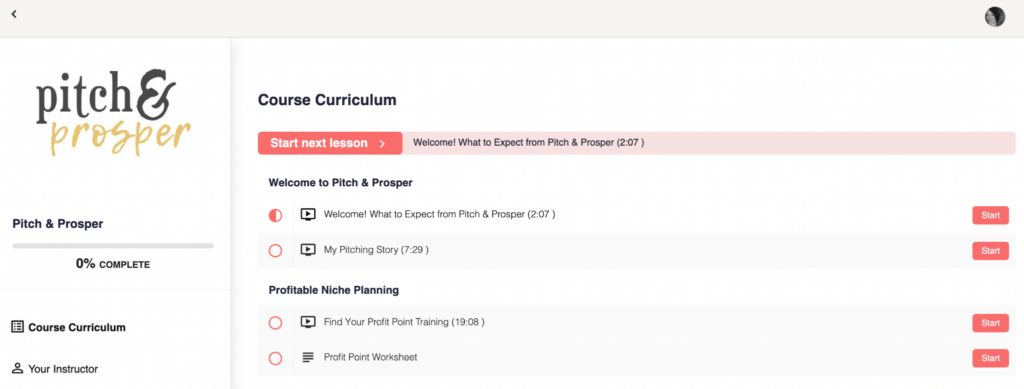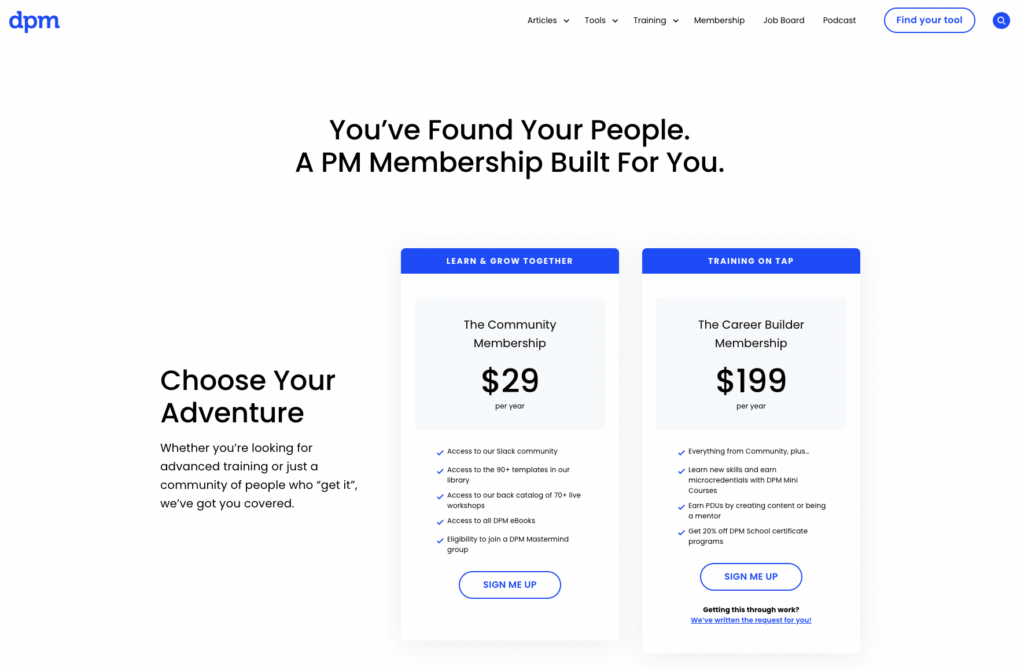Tooltester is supported by readers like yourself. We may earn an affiliate commission when you purchase through our links, which enables us to offer our research for free.
My copywriting business completely changed when I started to focus on community.
Sure, I was doing good work and having a nice time before, but building a name for myself and nurturing a group of loyal followers has opened so many doors. It’s boosted my industry authority, led to bigger and better projects and has helped me secure a reliable and stable income.
It all started when I quit my job and moved to Spain to freelance. All of a sudden, I was getting countless emails a week from people who wanted to do the same. I love helping other people out, but it was becoming a huge time-suck trying to respond to each and every question.
So I had a brainwave: Create a course that answered all these questions and helped people do what I did. Simple.
I began my search for a membership website builder where I could host my course. At the time (we’re talking five years ago), I received a lot of recommendations for Teachable. It served its purpose, but there are now a ton of new options available that have lots more features and are geared toward different industries, membership models, and content formats.
In this article, I’ll be reviewing some of the best membership website builders, highlighting which kind of creators they’re best for, and laying bare their pros and cons. Whether you’re looking to offer online yoga classes, writing courses, private coaching sessions, paid newsletters, or downloadables, there’s a membership builder for you.
Membership Website Builders vs Dedicated Membership Sites (like Teachable)
When I started creating courses and memberships, there weren’t a lot of options. Website builders weren’t really offering membership add-ons and, if they were, they were clunky and not particularly geared toward the new wave of online businesses.
There were plenty of dedicated membership website platforms, though—Teachable, Kajabi, Thinkific, Podia, and Teachery were all options, but Teachable seemed to fit my needs and budget best at the time.
These platforms were created specifically for hosting online courses and memberships, so their interfaces have everything you might need, but they can often be limited behind the scenes. For example, the backend of Teachable looks pretty much the same for every membership website, bar the branded colors and logos you can upload yourself.

This is the backend of my Pitch & Prosper course—the only thing I have control over is the button and accent color and logo.
It’s the same for most of these other dedicated platforms. They have everything you need to create complex membership programs, but they fall short when it comes to making them look the way you’d like them to look.
It can also be a headache hosting your membership separately from your website and having to constantly switch between the two. At least if you have your website and membership program in the same place, you’re able to get a comprehensive view of your analytics, conversion rates, and other key metrics that would otherwise be spread out over different platforms.
If you want full control of the backend of your membership program and want to keep all your metrics in one place, a membership website builder might be a better option. Here are my top picks.
The 9 Best Membership Website Builders
- Squarespace – Robust Website Builder for Creators
- Wix – Sell Subscriptions, Courses or Products
- SendOwl – Affordable Solution for Selling Exclusive Content
- Weebly – The Value Option
- WordPress – Complicated but Very Powerful
- HubSpot CMS Hub – All-in-One Marketing Suite
- Wild Apricot – Specialized Membership Website Builder
- Memberspace – The Add-On for Existing Websites
- GoDaddy website builder – Affordable but Limited
1. Squarespace
Squarespace is a popular website builder among the creator and entrepreneur crowd because you can build a beautiful, functioning site without an iota of design or development acumen.

Grow Well Coaching uses Squarespace’s Members Area for its coaching programs.
The drag-and-drop interface and the library of pre-made templates are an attractive selling point for creators who want to get set up quickly–or for those already using Squarespace for their websites–but it comes at a price. Squarespace takes 7% of each transaction for creators on the Starter package (less if you pay more each month). It’s not cheap, but that’s the price you pay for a quick and easy setup.
I use Squarespace for one of my websites (Copy Revival) and can confirm it’s pretty robust for creators who don’t need complicated backends and who just want a site that looks good (lightyears apart from my WordPress website that I’ve had to hire a handful of designers and developers for over the years!). The Members Area combined with their new Courses platform makes it easy to sell courses, programs, classes, and paid content behind the scenes.
They sell both features as the Digital Product Add-On (requires a Business or Commerce plan):
Starter at $9/month includes unlimited member areas and courses. It includes 10 hours of video storage. Transaction fee: 7%
Core at $34/month includes up to 50 hours of video storage and reduces the transaction fee to 3%.
Professional at $119/month removes the storage limit for videos as well as the transaction fee.

Passero Cooking School runs its classes through Squarespace.
Squarespace is best for…
Creators who are already using the platform (it’s far less hassle migrating across and you can keep members in one place) and who provide courses and programs, like virtual classes and one-time resources. Thanks to Courses you can also build complex, multi-module courses that include sequential lessons, chapters, and progress tracking.
The pros of Squarespace for memberships
- There’s a huge selection of pre-made templates
- The built-in analytics are comprehensive
- You just need one single login if your site is already hosted on Squarespace
- There’s a clean, tidy interface that is typical of Squarespace
The cons of Squarespace for memberships
- You need to purchase a separate subscription to access Squarespace Member Areas and Courses, and a large chunk of revenue goes on fees (if you don’t opt for the expensive Professional package)
Read our Squarespace review and get started for free.
2. Wix
Wix was voted our best website builder for 2023 for multiple reasons. There are plenty of templates that cater to a wealth of industries, there’s a super simple drag-and-drop interface, and it’s easy to grapple with the editor even if you’re not particularly internet savvy. I actually helped my mum set up a Wix website for her offline business. Calling her a tech-phobe is a massive understatement, so it’s a testament to Wix that she’s now able to manage and update the site herself without any problems.

Wix helps you customize your membership program based on your unique needs.
Wix’s membership feature is fueled by the Wix Bookings app. Integrating it with your existing Wix website (or with a brand new one) lets you set up a membership website in the backend and sell either packages or ongoing membership bundles.
Wix is best for…
Creators who are selling classes or products that can be bundled together. For example, fitness instructors selling blocks of online classes, or coaches offering a set number of sessions. In fact, my mum could probably make good use of Wix’s membership add-on for her psychotherapy sessions.

HERoines uses Wix to promote and host its member events.
The pros of Wix for memberships
- It’s easy to create different pricing plans for different levels of membership
- You can customize the member area for a slick backend experience
- The built-in progress tracker helps members track their journey
- You can easily offer free trials and discounts
- It’s easy to set recurring payments (Core plan and above)
The cons of Wix for memberships
- You can’t personalize registration emails (and no confirmation email is sent when users register if approval isn’t set to manual–eek!)
- It’s difficult to modify subscriptions once users are locked in
- There’s little flexibility to show the finer details of your membership on more than one page
Read our Wix review and get started for free.
3. SendOwl
SendOwl is one of our favorite tools for selling digital products, and with SendOwl Storefront, you can sell up to 10 products – including memberships – without needing your own website.
It’s ideal for selling memberships to newsletters, online courses, sponsorship options, and even services and physical products. I like that it’s possible to choose your payment frequency for recurring payments (e.g. monthly vs yearly), and even offer a trial period for your products.

A sample SendOwl storefront for selling membership products
SendOwl is best for…
SendOwl is an ideal solution for digital product sellers, content creators, and small businesses looking for a hassle-free and cost-effective membership platform. With affordable pricing starting at $9 per month, it’s a budget-friendly choice for marketers and businesses with a limited product range.
The pros of SendOwl for memberships
- Easy to set up
- Flexibility in how you deliver your products – give access to your content all at once or send it out as part of a drip sequence
- Supports multiple currencies
- Offers in-built marketing features such as abandoned cart emails and the ability to set up your own affiliate program
- Affordable pricing
The cons of SendOwl for memberships
- Maximum of 10 products in the storefront. To sell more, you’d need to feature the products on your own website
- Minimal customization options for the design of your storefront
- Sendowl branding visible in storefront
- Charges order management fees, including for free orders
4. Weebly
I use Weebly for my main website (LizzieDavey.com) which I set up about 10 years ago when Weebly was ahead of its time. Today, it feels a little clunky, but it’s still eager to keep up with the bigger names. The good thing about Weebly is it’s cheap. I pay $10 a month for a handful of features, so there’s that.

The backend of Weebly’s membership feature.
There are also some useful features, especially for creators who want an uncomplicated and simple backend. For example, you can segment members into groups based on their loyalty levels (I would love this option in Teachable) and it’s also really easy for members to sign up (again, something I would love to have on Teachable, which adds barriers to entry by asking students to create a Teachable account first).
Weebly is best for…
Creators who want cheap and easy! Weebly has a barebones membership website builder which would be a good fit for downloads, one-time resources, and hosting live classes. Despite it being super simple to use, it’s probably not the best option for larger, more complex offerings like courses and masterminds.

Our Table uses Weebly to run its community membership program.
The pros of Weebly for memberships
- It’s cheap!
- It’s easy to use with simple, basic features
- Its drag-and-drop interface is great for non-designers
- There’s a fully-stocked library of templates to choose from (although these are pretty limited compared to other options)
The cons of Weebly for memberships
- The features aren’t on par with other membership websites and are, in fact, a little out of date
- It doesn’t include the ability to offer paid content to members
- The features are limited compared to other options
- While the designs and templates are nicely responsive, they could be better
Read our Weebly review and get started for free.
5. WordPress
WordPress is the don of website creation and I’ve created my fair share of sites there over the years (Freelance Magic is a WordPress website). It takes a little more getting used to than the drag-and-drop options out there, but it is far more robust and has much more powerful capabilities than the others. In fact, it’s my go-to website builder when I want to create an all-singing, all-dancing website that I know will get increasingly complicated over time.
My favorite part? The plugins.
Plugins are what make WordPress so flexible since they often require very little design and development acumen but can help you customize your site in any way you want.

DPM offers its audience different membership tiers through the MemberPress plugin.
If you want to create a membership program on WordPress, you’ll need a trusty plugin. MemberPress is the most popular. Once you’ve integrated it with your WordPress backend, you can run courses, sell subscriptions, send paid newsletters, and create a members-only portal for your website. This is fantastic if you already have a WordPress site (which many people do!) since you can just tack on the plugin and go.
WordPress is best for…
Creators who are already using WordPress or who need a complex builder to suit their membership needs. But the sheer range of plugins means that pretty much anyone who wants to create a membership site of some kind can do so fairly easily with WordPress—it might just take a bit of time to play around with the options until you find something that works well for you.
The pros of WordPress for memberships
- It’s very adaptable for any kind of business
- There are tons of add-ons to personalize and customize your member’s area
- It’s easy to add to existing WordPress accounts or websites
- There are lots of payment processor options
The cons of WordPress for memberships
- It can end up being quite costly if you go for lots of add-ons (you often pay for each individual plugin–and sometimes each individual plugin feature)
- It can be a learning curve trying to get to grips with the interface
- You need to have a self-hosted WordPress website to create a membership area
Read our WordPress review and get started for free.
6. HubSpot CMS Hub
HubSpot is inherently a CRM, but it offers a wide range of marketing automation tools, as well as its own website builder. You can customize your website by segmenting members into different sub-groups and delivering content specifically for them—kind of like account-based marketing.
The membership feature is powerful, particularly if you’re selling B2B services and products. For example, you can provide updates to different segments and different times, like sellers, leads, and internal stakeholders, which means you can personalize the entire lead generation experience from start to finish.

The Room uses HubSpot CMS Hub as a place to bring together its brands and influencers.
HubSpot CMS Hub is best for…
B2B brands with different audiences. The segmentation capabilities are really what set this apart from the other membership site builders here and it’s great for delivering marketing materials to leads (ABM style!) and nurturing existing customers in different segments.
The pros of HubSpot CMS Hub for memberships
- There are powerful segmentation capabilities
- You can easily integrate tons of other tools and software
- It has great marketing features, including email, advanced SEO settings, and conversion-powered landing pages
The cons of HubSpot CMS Hub for memberships
- The backend can be tricky to get your head around
- The sheer amount of tools and features can be overwhelming
- It can end up being pretty pricey
Read our HubSpot CMS Hub review and get started for free.
7. Wild Apricot
Wild Apricot is the wildcard here (pun very much intended). It’s a lesser-known membership website builder but competes with the big guns thanks to its selection of powerful features.
Unlike the other subscription website builders listed here that cater to all sorts of online businesses, Wild Apricot has carved a niche for itself as a membership website builder for offline organizations–we’re talking non-profits, business associations, charities, and community organizations that run regular events and have a healthy number of members (the backend lets you welcome and manage up to 15,000 members). It also has handy localization features for promoting events in your area and it lets you easily recruit members and run online courses and classes too.

Clarksburg Wine Growers & Vintners uses Wild Apricot to build a community.
Compared to the others here, Wild Apricot is more of a traditional membership website builder, complete with a renewals feature, event reminders, and easy communication between members.
Wild Apricot is best for…
Local organizations, businesses, and charities that run events, live classes, and workshops for lots of members. Think local street parties, marathons, and local interest events that want to provide an online element to a mostly offline audience.
The pros of Wild Apricot for memberships
- It handles every part of running a traditional membership group
- There’s an in-built member forum for easy communication
- It’s quick and easy to get set up and started
The cons of Wild Apricot for memberships
- It’s limited in its customizations
- There aren’t as many features as the other website builders here
- It provides very little backend data
Get started with Wild Apricot.
8. Memberspace
Memberspace is less of a standalone membership website builder and more of an add-on to existing websites. It’s ideal for creators without a lot of design and development experience because it doesn’t need any coding—plus, you can integrate it with the CMS you’re already using without the hassle of switching over.

Ladies of Real Estate uses Memberspace to host its collection of downloadable templates.
The best part is it was built specifically for creators, publishers, and educators, so it has lots of ideal features for these types of businesses. It also has a pretty robust ecosystem for upsells, cross-sells, and tiered offers so you can create a complex and comprehensive membership program (and make more sales while you’re at it!). I’d love a simpler way to add upsells and different levels of membership on Teachable.
Memberspace is best for…
Most use cases! The robust features can support a wide range of membership models, from small creators selling membership libraries, paid newsletters, and one-off live classes; to bigger brands selling complex courses with multiple levels of membership.

Cave Day uses Memberspace to host its members-only work sessions.
The pros of Memberspace for memberships
- It can easily add-on to an existing CMS and you can move the software with you if you decide to move CMS in the future
- It keeps members on your website at all times
- There are handy automated marketing features to engage and convert members
The cons of Memberspace for memberships
- There are limited payment options for members
- There aren’t as many design or customization features as other website builders for subscription services
- The analytics can be clunky
9. GoDaddy Website Builder
I use GoDaddy for some of my domain names, but it also has a website builder. If you do a little bit of research, you’ll see that it’s received some flack in the past for being too restrictive, but the latest version aims to quash those negative reviews with a modern interface and a totally free plan.
The membership option is only available at a basic level. So, while it does enable member accounts, you can only create private pages and give permission to certain people rather than host courses and live events. Great if you’ve got a simple idea in mind, but not so great if you have big plans for your membership program.

Women Working in Technology uses GoDaddy to share its workshops and events.
GoDaddy is best for…
Creators who are already using a GoDaddy website or who only need a basic membership website for an affordable price. If you simply need a private page to direct paying customers to, this can be a great cost-effective option.
The pros of GoDaddy for memberships
- It’s easy to use the backend interface
- The membership format is simple and easy-to-use
- It’s very affordable
The cons of GoDaddy for memberships
- You’re limited in what you can do with it
- It’s difficult to customize and personalize the backend
- There aren’t a lot of additional features and you can’t integrate external software
Read our GoDaddy review and get started for free.
Choosing the Best Membership Website Builder For You
There weren’t a lot of options when I was looking for a membership website builder five years ago. Today, you have a ton of choices—so it’s important to choose wisely!
Consider the type of membership program you want to run and use that to determine what features you’ll need and what platform is the best fit for you. For example, I needed a membership website where I could run multi-module courses, but you might need something a little simpler if you’re selling one-off classes or paid-for downloads.
There’s a reason Squarespace and Wix are our top picks. Both builders offer highly-customizable membership areas that make it easy to add content with drag-and-drop interfaces and beautiful templates. Look for builders that can grow with you, too. It can be a headache having to migrate everything you’ve worked so hard to build onto another platform if you suddenly feel restricted by the features available to you.
Please let me know if you have any feedback about creating a membership website!
We keep our content up to date
23 Feb 2024: Added SendOwl
THE BEHIND THE SCENES OF THIS BLOG
This article has been written and researched following a precise methodology.
Our methodology

